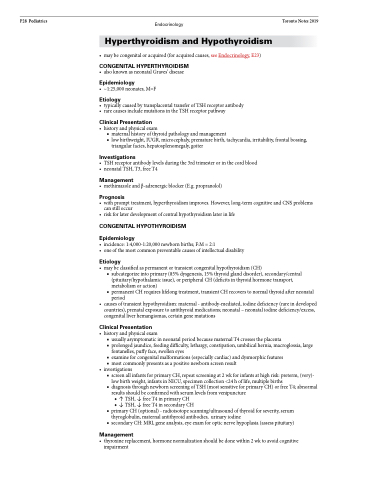Page 1062 - TNFlipTest
P. 1062
P28 Pediatrics
Endocrinology
Toronto Notes 2019
Hyperthyroidism and Hypothyroidism
• maybecongenitaloracquired(foracquiredcauses,seeEndocrinology,E23) CONGENITAL HYPERTHYROIDISM
• alsoknownasneonatalGraves’disease
Epidemiology
• ~1:25,000neonates,M=F
Etiology
• typicallycausedbytransplacentaltransferofTSHreceptorantibody • rarecausesincludemutationsintheTSHreceptorpathway
Clinical Presentation
• historyandphysicalexam
■ maternal history of thyroid pathology and management
■ low birthweight, IUGR, microcephaly, premature birth, tachycardia, irritability, frontal bossing,
triangular facies, hepatosplenomegaly, goiter
Investigations
• TSHreceptorantibodylevelsduringthe3rdtrimesterorinthecordblood • neonatalTSH,T3,freeT4
Management
• methimazoleandβ-adrenergicblocker(E.g.propranolol)
Prognosis
• withprompttreatment,hyperthyroidismimproves.However,long-termcognitiveandCNSproblems can still occur
• riskforlaterdevelopmentofcentralhypothyroidismlaterinlife
CONGENITAL HYPOTHYROIDISM
Epidemiology
• incidence:1:4,000-1:20,000newbornbirths;F:M=2:1
• oneofthemostcommonpreventablecausesofintellectualdisability
Etiology
• maybeclassifiedaspermanentortransientcongenitalhypothyroidism(CH)
■ subcategorize into primary (85% dysgenesis, 15% thyroid gland disorder), secondary/central
(pituitary/hypothalamic issue), or peripheral CH (deficits in thyroid hormone transport,
metabolism or action)
■ permanent CH requires lifelong treatment, transient CH recovers to normal thyroid after neonatal
period
• causesoftransienthypothyroidism:maternal-antibody-mediated,iodinedeficiency(rareindeveloped
countries), prenatal exposure to antithyroid medications; neonatal – neonatal iodine deficiency/excess, congenital liver hemangiomas, certain gene mutations
Clinical Presentation
• historyandphysicalexam
■ usually asymptomatic in neonatal period because maternal T4 crosses the placenta
■ prolonged jaundice, feeding difficulty, lethargy, constipation, umbilical hernia, macroglossia, large
fontanelles, puffy face, swollen eyes
■ examine for congenital malformations (especially cardiac) and dysmorphic features ■ most commonly presents as a positive newborn screen result
• investigations
■ screen all infants for primary CH, repeat screening at 2 wk for infants at high risk: preterm, (very)-
low birth weight, infants in NICU, specimen collection <24 h of life, multiple births
■ diagnosis through newborn screening of TSH (most sensitive for primary CH) or free T4; abnormal
results should be confirmed with serum levels from venipuncture ◆ ↑ TSH, ↓ free T4 in primary CH
◆ ↓ TSH, ↓ free T4 in secondary CH
■ primary CH (optional) - radioisotope scanning/ultrasound of thyroid for severity, serum thyroglobulin, maternal antithyroid antibodies, urinary iodine
■ secondary CH: MRI, gene analysis, eye exam for optic nerve hypoplasia (assess pituitary)
Management
• thyroxinereplacement,hormonenormalizationshouldbedonewithin2wktoavoidcognitive impairment


